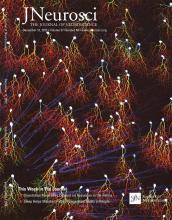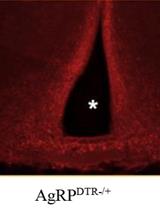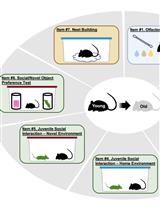- EN - English
- CN - 中文
Buried Food-seeking Test for the Assessment of Olfactory Detection in Mice
使用寻找掩埋食物试验评估小鼠的嗅觉探测能力
发布: 2018年06月20日第8卷第12期 DOI: 10.21769/BioProtoc.2897 浏览次数: 10891
评审: Deepika SuriAlexandra GrosAnonymous reviewer(s)

相关实验方案
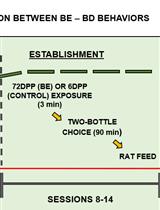
从食物到酒精的狂饮:雄性Wistar大鼠嗜酒行为之间的顺序相互作用
Sergio Cuesta-Martínez [...] Cruz Miguel Cendán
2023年08月05日 829 阅读
Abstract
The sense of smell allows animals to discriminate a large number of volatile environmental chemicals. Such chemical signaling modulates the behavior of several species that depend on odorant compounds to locate food, recognize territory, predators, and toxic compounds. Olfaction also plays a role in mate choice, mother-infant recognition, and social interaction among members of a group. A key assay to assess the ability to smell odorants is the buried food-seeking test, which checks whether the food-deprived mice can find the food pellet hidden beneath the bedding in the animal’s cage. The main parameter observed in this test is the latency to uncover a small piece of chow, cookie, or other pleasant food, hidden beneath a layer of cage bedding, within a limited amount of time. It is understood that food-restricted mice which fail to use odor cues to locate food within a given time period are likely to have deficits in olfactory abilities. Investigators who used the buried food test, or versions of the buried food test, demonstrated that it is possible to evaluate olfactory deficits in different models of murine studies (Alberts and Galef, 1971; Belluscio et al., 1998; Luo et al., 2002; Li et al., 2013). We have recently used this assay to demonstrate that olfactory-specific Ric-8B knock-out mice (a guanine nucleotide exchange factor that interacts with olfactory-specific G-protein) show an impaired sense of smell (Machado et al., 2017). Here we describe the protocol of the buried food-seeking test, as adopted in our assays.
Keywords: Buried food-seeking test (寻找掩埋食物试验)Background
The buried food-seeking test was first described in 1971 (Alberts and Galef, 1971). Since then, additional versions of the test have been described. This test has been used to investigate the consequences of olfactory impairment in a variety of situations, such as: analysis of the effects of olfactory function on the performance of female mice in social behavior towards male conspecifics (Yamada et al., 2001), the discrimination of the participation of both the main olfactory system and the vomeronasal organ in behavior (Del Punta et al., 2002) or in animal models of hyposulphataemia, a disturbance in sulphate metabolism (Dawson et al., 2005). It was also used to assess sociability and cognitive function in neuronal cell adhesion molecule (Nrcam) null mice (Moy et al., 2009), to study the effects of the selective non-imidazole histamine H3 receptor antagonist in anxiety and depression-like disorders (Bahi et al., 2014), to analyze the role of endocannabinoids in olfactory sensory neurons (Hutch et al., 2015), and others. There are variations in the buried food test methods used in these studies. For example, some authors used pre-test acclimation in the testing cage to reduce novelty-induced exploratory activity during the olfaction test, while others did not. It is important to note that this acclimation can help in decreasing response variability within groups. In our previous work, we used the buried food test, in association with other motivational, behavioral, and cellular tests, to determinate whether the sense of smell is impaired in olfactory-specific Ric-8B knock-out mice (Machado et al., 2017). The present manuscript describes the protocol of the buried food-seeking test as adopted in our previous assays, in order to observe aspects of olfactory deficits in mice.
Materials and Reagents
- Mice should be at least 8-week-old
Notes:- We used 8-week-old C57BL/6J background mice of both sexes, it is important that the animals have the same age.
- It is possible to use this protocol with other strains of mice. It might be applicable to rats as well, but needs standardization of procedures, such as: size of the cage, depth of the bedding, size of the chow pellet, as well as food deprivation time.
- In females, estrus can effect olfactory discrimination. Considering this, we initially did statistical analysis in separating genders: wild-type (4 males and 5 females), heterozygote (3 males and 3 females) and conditional knock-out mice (4 males and 5 females). However, we observed no differences between genders, so in our final results, we used both genders in all groups. We recommend evaluating the differences between genders before deciding to use mixed-gender groups or not.
- We used 8-week-old C57BL/6J background mice of both sexes, it is important that the animals have the same age.
- Filtered and autoclaved water
- Chow pellets (Food stimulus)
Notes:- We used a 2 g pellet of the same chow the animals were regularly fed with.
- We used AIN-93G chow (for use during rapid growth, pregnancy and lactation, from Rhoster, described in Reeves et al. (1993), because it was the chow type regularly fed to our animals.
- Other types of pleasant foods have been previously used as stimulus, such as: Oreo cookie, Kellog’s Fruit Loops, chow covered in peanut butter and other. We found, however, that Kellog’s Fruit Loops did not stimulate foraging through olfactory cues in the mice. In our experiments, regular food chow pellets showed better results in foraging behavior than the Fruit Loops. This may be due to novelty induced hypophagia, so we recommend the use of food stimulus that the animals are accustomed to in order to avoid novelty induced hypophagia.
- We used a 2 g pellet of the same chow the animals were regularly fed with.
Equipment
- Experimental animal room
Note: An adequate procedure room is essential for the successful development of the behavior test, since it is sensitive to external distractions. This requirement should be carefully considered during the planning stages. An adequate procedure room consists of an isolated and silent experimentation room, where it is possible to avoid the entrance of people during the test. - Clean mouse cage of a regular size (30.5 cm length x 16 cm width x 16 cm height or similar) (Figure 1) (We used the M.I.C.E.® Animal Care Systems cage [Animal Care Systems, catalog number: M/P 79010 ])
Note: Do not use regular cage lids. The stainless-steel top which holds food and water interferes with observation and should not be included in the setup. If needed, it is best to use acrylic lids.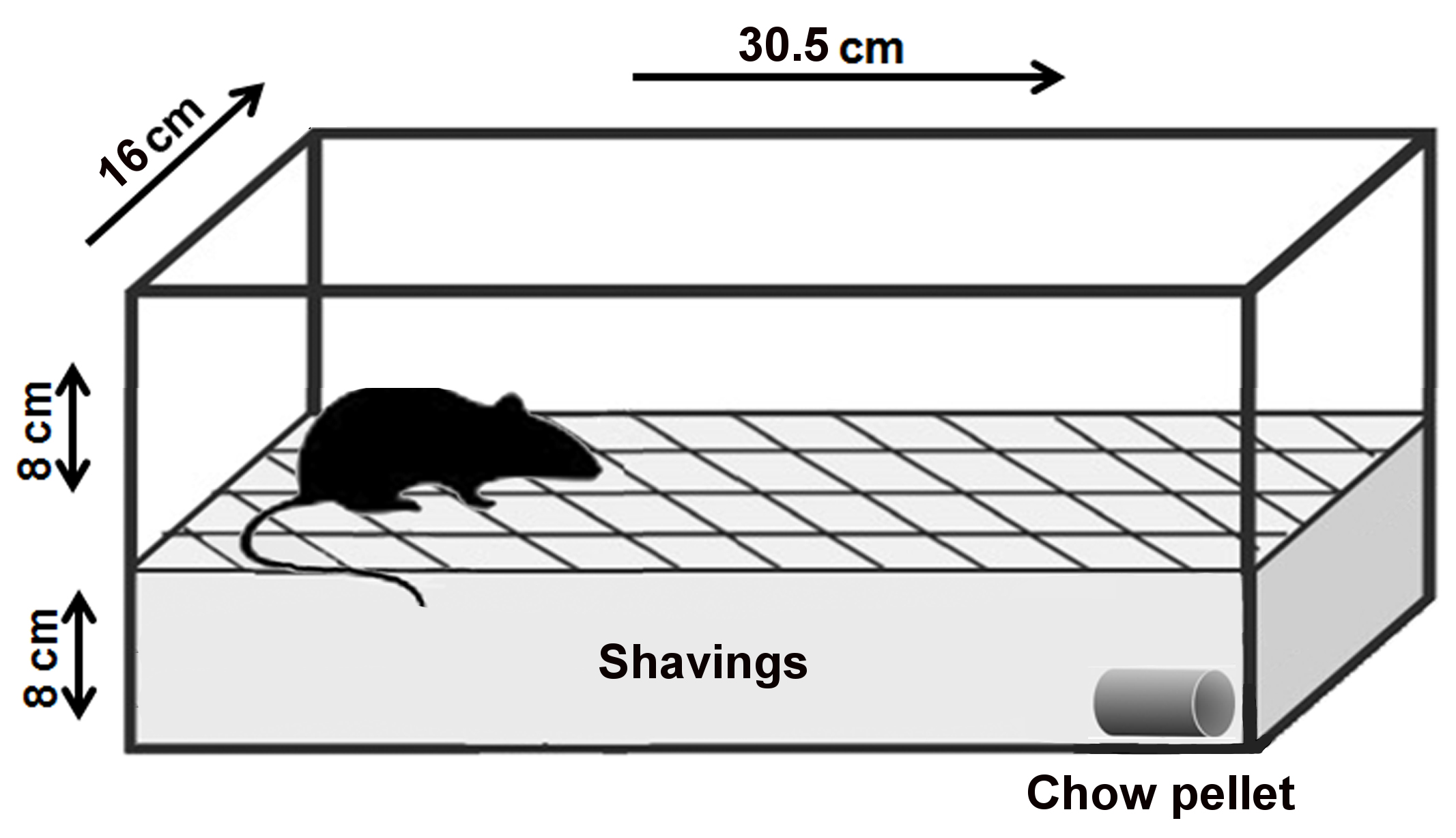
Figure 1. Layout of the buried food-seeking test. The purpose of this experimental test is to measure the animal's ability to use olfactory cues for foraging. The main parameter measured in this test is the latency to find the hidden food. Latency is defined as the time between when the mouse was placed in the cage and when the mouse uncovered the food pellet. For the test, 8-week-old mice were deprived of food for 24 h but received water ad libitum. Next day, a 2 g pellet of regular chow was buried 8 cm beneath the surface of the fresh bedding in one end of a clean test cage. The site of animal placement and the site at which the pellet was buried remained constant. - Fresh cage bedding to create an 8 cm layer in each cage
Notes:- For each subject, a clean cage washed and dried by the animal care cage washing facility and clean bedding should be used. Do not re-use cages or bedding.
- Cage lining: we use Premium Hygienic Animal Bedding LIGNOCEL® FS-14 to bury the pellet.
- For each subject, a clean cage washed and dried by the animal care cage washing facility and clean bedding should be used. Do not re-use cages or bedding.
- Portable digital scale (Denver Instrument, model: TR-403 , or equivalent scale)
Note: To weigh the pellet chow, we used a digital scale (Denver Instrument, TR-403, Max = 410 g, d = 0.001g). - Digital stopwatch
Note: The stopwatch is used to monitor the test length. - Digital video camera (optional, we used Sony Cyber-shot 14.1 mega pixels) (Sony, model: DSC-W330 )
Notes:- The presence of a human observer may influence animal behavior. The use of a video camera may help reduce human interference during the test.
- All videos were recorded in .avi format and viewed using VLC media player.
- The presence of a human observer may influence animal behavior. The use of a video camera may help reduce human interference during the test.
Procedure
文章信息
版权信息
© 2018 The Authors; exclusive licensee Bio-protocol LLC.
如何引用
Readers should cite both the Bio-protocol article and the original research article where this protocol was used:
- Machado, C. F., Reis-Silva, T. M., Lyra, C. S., Felicio, L. F. and Malnic, B. (2018). Buried Food-seeking Test for the Assessment of Olfactory Detection in Mice. Bio-protocol 8(12): e2897. DOI: 10.21769/BioProtoc.2897.
- Machado, C. F., Nagai, M. H., Lyra, C. S., Reis-Silva, T. M., Xavier, A. M., Glezer, I., Felicio, L. F. and Malnic, B. (2017). Conditional deletion of Ric-8b in olfactory sensory neurons leads to olfactory impairment. J Neurosci 37(50): 12202-12213.
分类
神经科学 > 行为神经科学 > 实验动物模型
您对这篇实验方法有问题吗?
在此处发布您的问题,我们将邀请本文作者来回答。同时,我们会将您的问题发布到Bio-protocol Exchange,以便寻求社区成员的帮助。
提问指南
+ 问题描述
写下详细的问题描述,包括所有有助于他人回答您问题的信息(例如实验过程、条件和相关图像等)。
Share
Bluesky
X
Copy link




